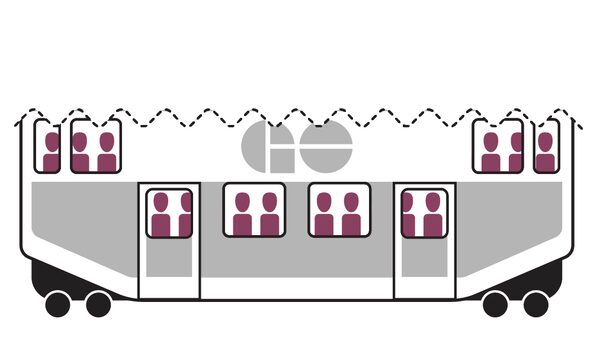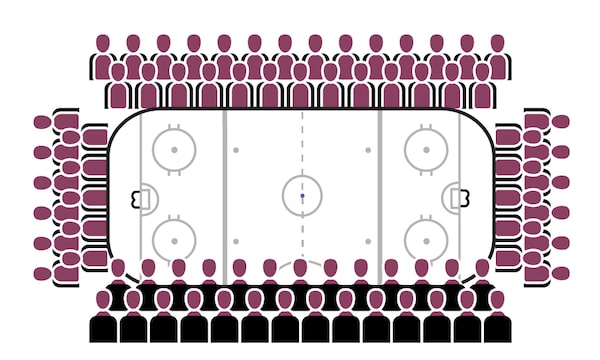In the last Ontario election, roughly one in five ridings had slim margins of victory where the difference between the elected candidate and the runner-up was less than five percentage points. Many of these close calls are still races to watch for the 2022 election. We crunched the numbers and found that in some ridings, the margins were quite significant – think local hockey rink capacities. In others, the vote difference between winning and losing can be boiled down to your fellow commuters on the bus. Here are what some of these slim margins from 2018 look like, using examples from everyday life.
Update: Take a look at how these key ridings fared in Ontario’s 2022 election map
Illustrations by Murat Yükselir. With reports from Mahima Singh.
Scarborough—Guildwood
2018 margin of victory: 0.2 percentage points

Liberal Mitzie Hunter won by 74 votes, or about the same number of riders on one-and-a-half of the Toronto Transit Commission’s standard-sized buses in rush hour.
It was the smallest margin of victory in the last election (0.2 percentage points), with the Progressive Conservatives finishing second. It was also a three-way race, with the difference between the winner and the third place NDP candidate at less than 10 percentage points.
Ms. Hunter won by a razor’s edge amid a massive Liberal collapse that booted the party from government and left it with just seven seats in the legislature. Polls suggest support for the party has rebounded, and Ms. Hunter has the advantage that comes with serving at Queen’s Park. She won the riding handily in 2014, with more than 50 per cent of the vote. Her main challengers this time are the NDP’s Veronica Javier, a social worker and community advocate, and PC candidate Alicia Vianga, an entrepreneur who founded a charity to help breast cancer survivors.
Thunder Bay-Atikokan
2018 margin of victory: 0.3 percentage points

In Thunder Bay-Atikokan, the NDP won by 81 votes, about the number of passengers on a Porter Airlines plane, flying from Thunder Bay to Billy Bishop Toronto City Airport.
This riding had long been Liberal until the NDP’s Judith Monteith-Farrell picked it up in 2018, defeating Bill Mauro, a cabinet minister who had held the seat for 15 years – another casualty of the collapse of Liberal support under Kathleen Wynne. (He went on to win the mayor’s job in Thunder Bay that fall.) Ms. Monteith faces PC candidate Kevin Holland, a businessman who is mayor of the Thunder Bay-area Township of Conmee, and Liberal Rob Barrett, who has run several community service organizations, including an emergency shelter.
Brampton Centre
2018 margin of victory: 0.3 percentage points

NDP’s Sara Singh, the party’s deputy leader, won over her PC rival by just 89 votes, roughly the number of riders on half of a bi-level GO Transit train.
Brampton is seen by all three parties as a battleground, with the party leaders making frequent visits here on the campaign trail. This time Ms. Singh faces new PC candidate Charmaine Williams, the first Black woman elected to Brampton City Council (in 2018) and Liberal Safdar Hussain, a lawyer who runs a real estate business and who placed a distant third in 2018.
Ottawa West-Nepean
2018 margin of victory: 0.3 percentage points

Ottawa West-Nepean was another riding with a three-way race in 2018. The difference between PC Jeremy Roberts and runner-up NDPer Chandra Pasma was 175 votes, approximately the number of filmgoers in a packed screening at the largest theatre at Cineplex Ottawa.
Veteran Liberal cabinet minister and former Ottawa mayor Bob Chiarelli had held the seat until 2018, but finished third and about three percentage points behind the front-runners. (He is now running for mayor again.)
This time around, Mr. Roberts faces a rematch with Ms. Pasma, a researcher with the Canadian Union of Public Employees. The Liberal candidate is Sam Bhalesar, a senior communications adviser at Natural Resources Canada.
Don Valley West
2018 margin of victory: 0.4 percentage points

Defeated Liberal premier Kathleen Wynne hung onto the seat she had held since 2003 by just 181 votes – roughly the number of guests of a seated wedding dinner in the Floral Hall of the Toronto Botanical Garden.
Her party was reduced to just seven seats and denied full party status, but Ms. Wynne stayed on as her riding’s representative until the legislature was dissolved. She is not running again.
Her replacement as Liberal candidate in this keenly watched riding is Stephanie Bowman, a veteran of senior roles in the financial industry who has served on the board of the Bank of Canada. The Progressive Conservatives are running former Toronto police chief Mark Saunders. The NDP candidate is Irwin Elman, whose post as Ontario child advocate was eliminated by the PCs.
Brantford-Brant
2018 margin of victory: 1.1 percentage points

The margin of victory for Progressive Conservative Will Bouma was 635 votes, about the number of seats for two of the rinks at the Wayne Gretzky Sports Centre.
Traditionally a Liberal seat, the party’s long-time MPP and former speaker of the legislature, Dave Levac, declined to run in 2018. But Liberal Ruby Toor, who is running again, placed a distant third that year. The NDP have a high-profile new face this time in Harvey Bischof, the former head of the Ontario Secondary School Teachers’ Federation who clashed with the PC government early in its term over class sizes. Mr. Bouma faced calls to resign from opposition leaders after a left-leaning website said that before he was elected, he was an executive on a church committee that oversaw a youth magazine that urged young people to reject “the homosexual lifestyle” and supported conversion therapy. Mr. Bouma responded on Twitter that he was a “proud, loving, and supportive father to a daughter who is a member of the LGBTQ community.”
Toronto-St. Paul’s
2018 margin of victory: 2.6 percentage points

Toronto-St. Paul’s was another three-way race in the last election, with the NDP prevailing over the Liberals by 1,345 votes, just shy of a full-house event at Casa Loma.
This seat, traditionally a Liberal stronghold, was won by the NDP’s Jill Andrew after the riding was rendered an open race by Liberal health minister Eric Hoskins’ decision to step down three months before the 2018 vote. Now, Ms. Andrew faces a tough fight against Liberal Nathan Stall, a doctor who sat on the province’s COVID-19 Science Advisory Table and became a prominent critic of the PC government during the pandemic. Running for the PCs is Blake Libfeld.
Want to hear more about the Ontario election from our journalists? Subscribe to Vote of Confidence, a twice-weekly newsletter dedicated to the key issues in this campaign, landing in your inbox starting May 17 until election day on June 2.
 Jeff Gray
Jeff Gray